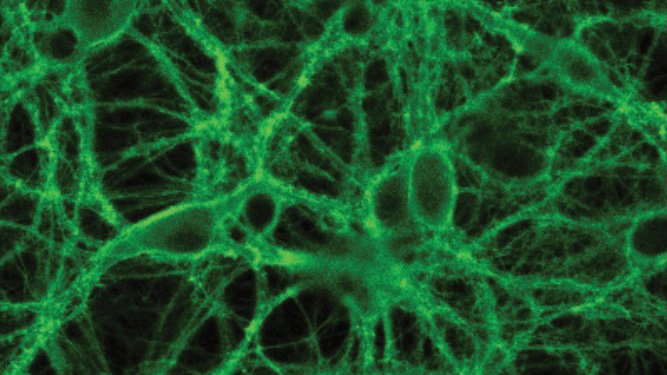
Image source: UZH
News • Neuropeptide research
Fluorescent biosensor to shed light on narcolepsy
Neuropeptides play fundamental roles in modulating cellular and circuit functions within the brain. One such signaling molecule – orexin – regulates arousal and wakefulness, and its failure can lead to constant daytime sleepiness (narcolepsy). University of Zurich researchers have now developed a fluorescent orexin biosensor to observe this molecule "live" in the living mouse brain.
The researchers present their findings in the journal Nature Methods.
In the brain, billions of neural cells act in concert to coordinate both basic and higher functions of the organism. They use a special language to communicate with each other: molecules known as neuropeptides or neurotransmitters. One example of such a signaling molecule system is orexin. Normally, it regulates arousal, wakefulness, motivation and appetite. Defects in the release or sensing of orexin neuropeptides cause, both in humans and in animals, a disease called narcolepsy. Affected individuals suffer from overwhelming daytime drowsiness and often exhibit cataplexic states, in which they remain conscious but are unable to control body movement, resulting in a sort of paralysis.
Recommended article

News • The science of sleep
How our brain works against 'night owls'
‘Night owls’ – those who go to bed and get up later – have fundamental differences in their brain function compared to ‘morning larks’ , which mean they could be disadvantaged by the constraints of a normal working day.
Tommaso Patriarchi from the Institute of Pharmacology and Toxicology at the University of Zurich (UZH) and his team have now developed a genetically encoded biosensor whose fluorescent properties enable them to study orexin action and release mechanisms 'live' and with high-resolution in the brain of living mice. "The direct link between this particular neuropeptide system and its dramatic alteration in human brain functions in narcolepsy, led us to study orexin in more detail", says Patriarchi. The new orexin biosensor named OxLight1 is based on a specially designed green fluorescent protein integrated into the human orexin receptor. "Marking the receptor with a fluorescent protein makes it visible under the microscope. When the neuropeptide binds to the receptor, it makes it light up", Patriarchi adds. OxLight1 thus offers practically a real-time outlook on orexin release in living animals like the mouse.
"To understand how neuropeptides systems like orexin act to maintain a healthy brain function, we need to be able to first observe the messages carried by these neuropeptides and then learn to interpret them", says Patriarchi. Up to now, this has been practically impossible due to the lack of tools that could provide a readout with high spatial and temporal resolution. The researchers therefore used their new biosensor to investigate the relationship between neuronal activity and neuropeptide release in living animals, one of the most pressing and long-sought questions in neurophysiology that has remained elusive until now.
They showed that the level of orexin release correlates with both frequency and duration of neuronal activation. "The exquisite sensitivity and speed of OxLight1 allowed us to track endogenous orexin release associated with natural behaviors such as spontaneous running or acute stress", says Patriarchi. As a result, they were able to demonstrate in the living brain that orexin signals can occur in the form of relatively short-lived, or 'phasic' bursts of release.
The team then investigated orexins dynamics across sleep/wake transitions. By combining photometry imaging of orexin dynamics and neuronal activity recordings to score the sleep status of the animals, the researchers observed for the first time that a rapid drop in orexin levels occurs during REM sleep of the mice. Further work with colleagues from the Istituto Italiano di Tecnologia in Italy, experts in two-photon microscopy, revealed another so far unknown process: spatially localized orexin fluctuations occurring in the somatosensory cortex upon awakening from anesthesia. This latter collaborative work was conducted within the framework of the recently awarded European project DEEPER. "After deciphering orexin release and neuronal activity in the healthy brain, we are now using OxLight1 to investigate the mechanisms of brain diseases like narcolepsy and addiction", says Tommaso Patriarchi. This research is the first outcome of a project for which Tommaso Patriarchi received an ERC Starting Grant in 2020. The biosensors that his team has developed are now being used to investigate brain function in laboratories around the world. By continuing to expand their neuro-technological toolbox the researchers also aim to establish next-generation screening assays for drug development.
Source: University of Zurich
15.02.2022











